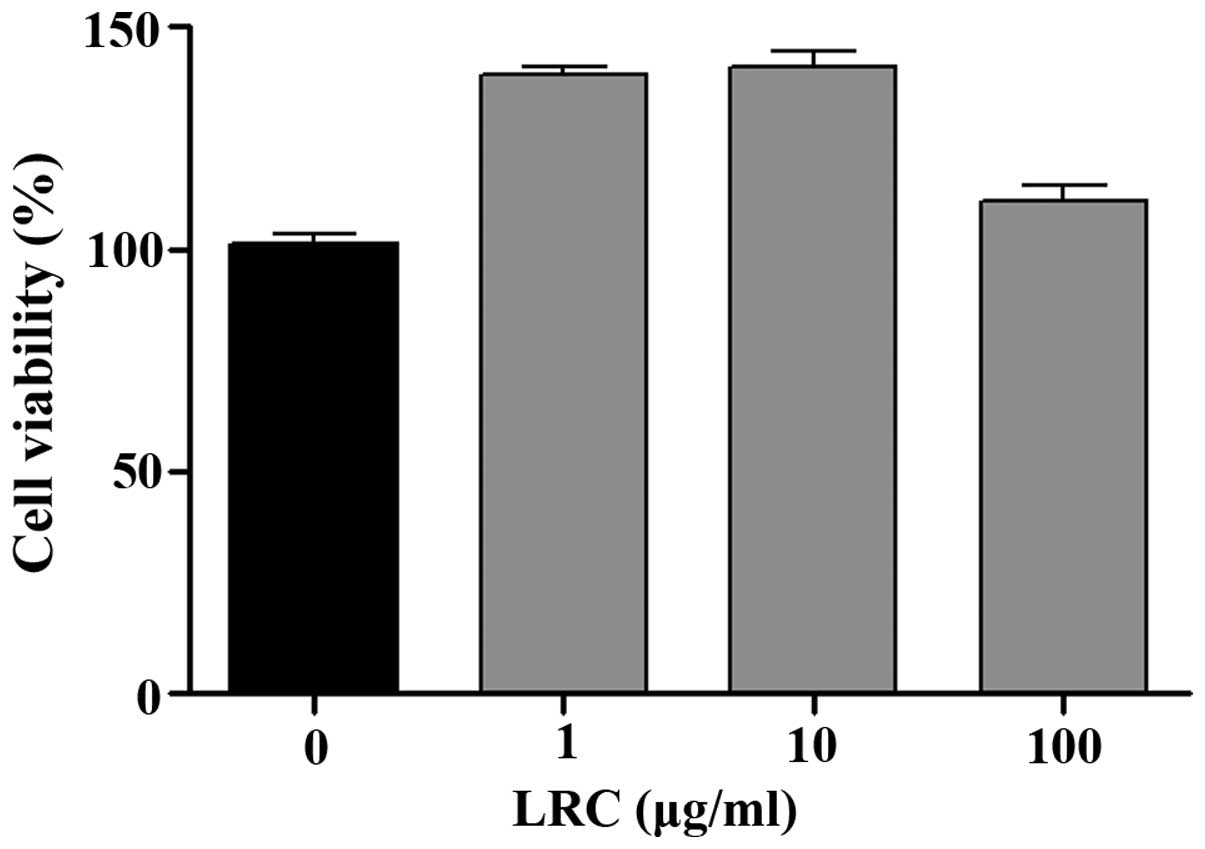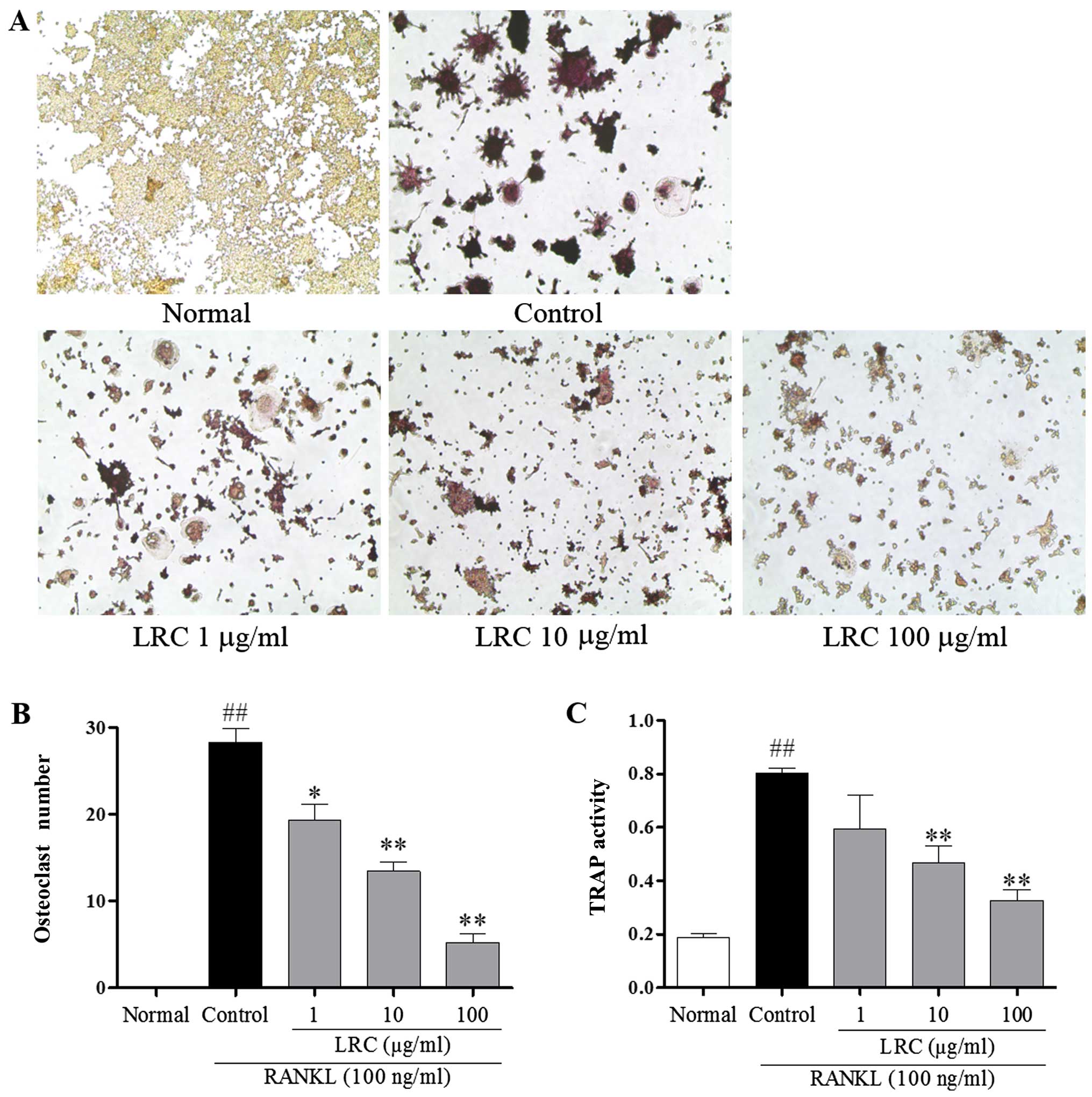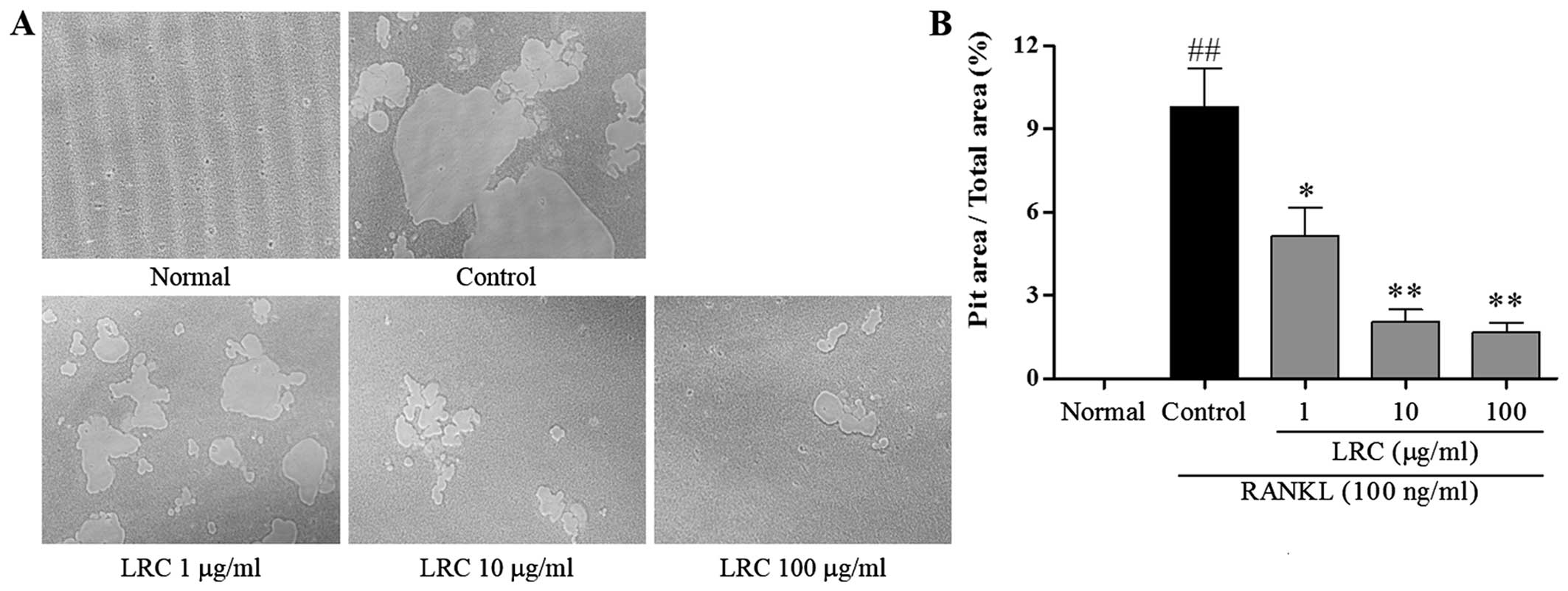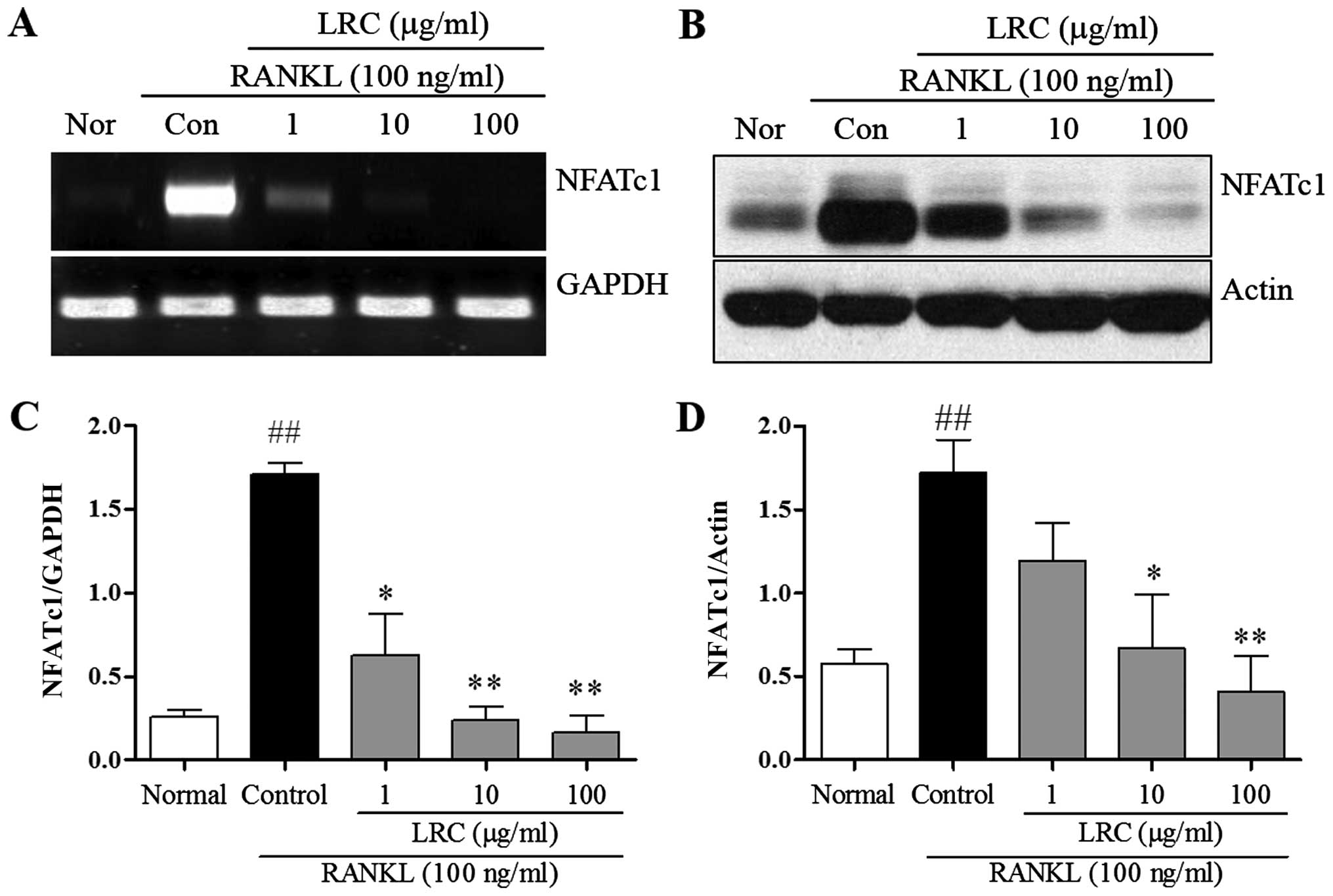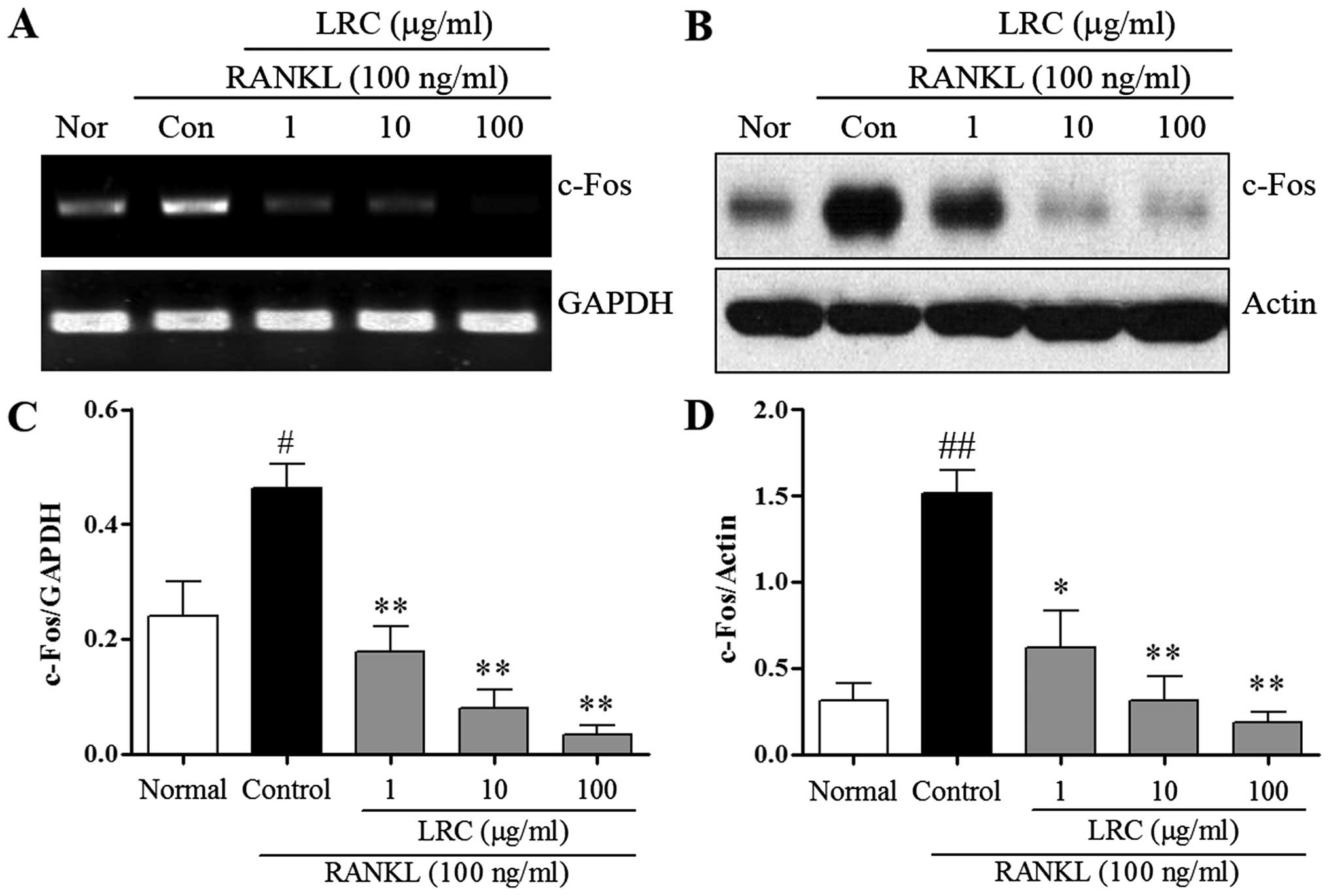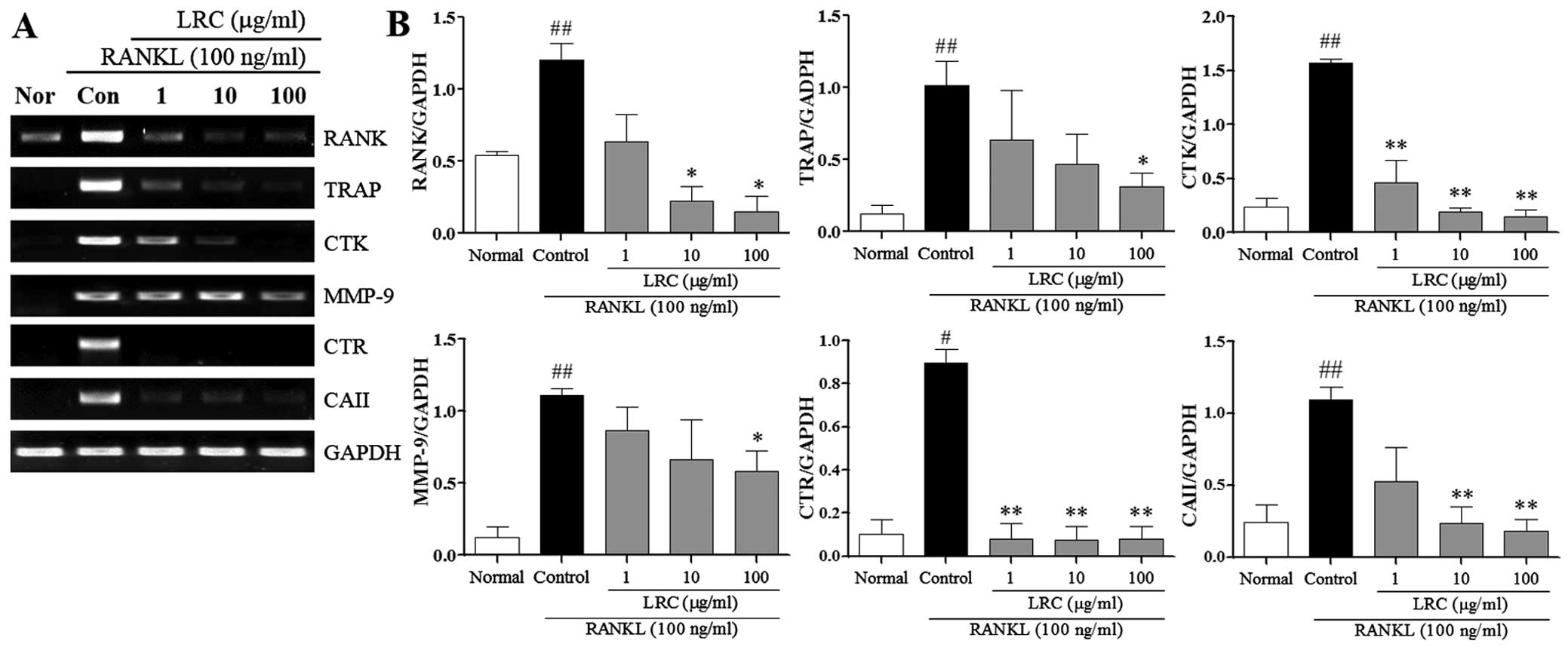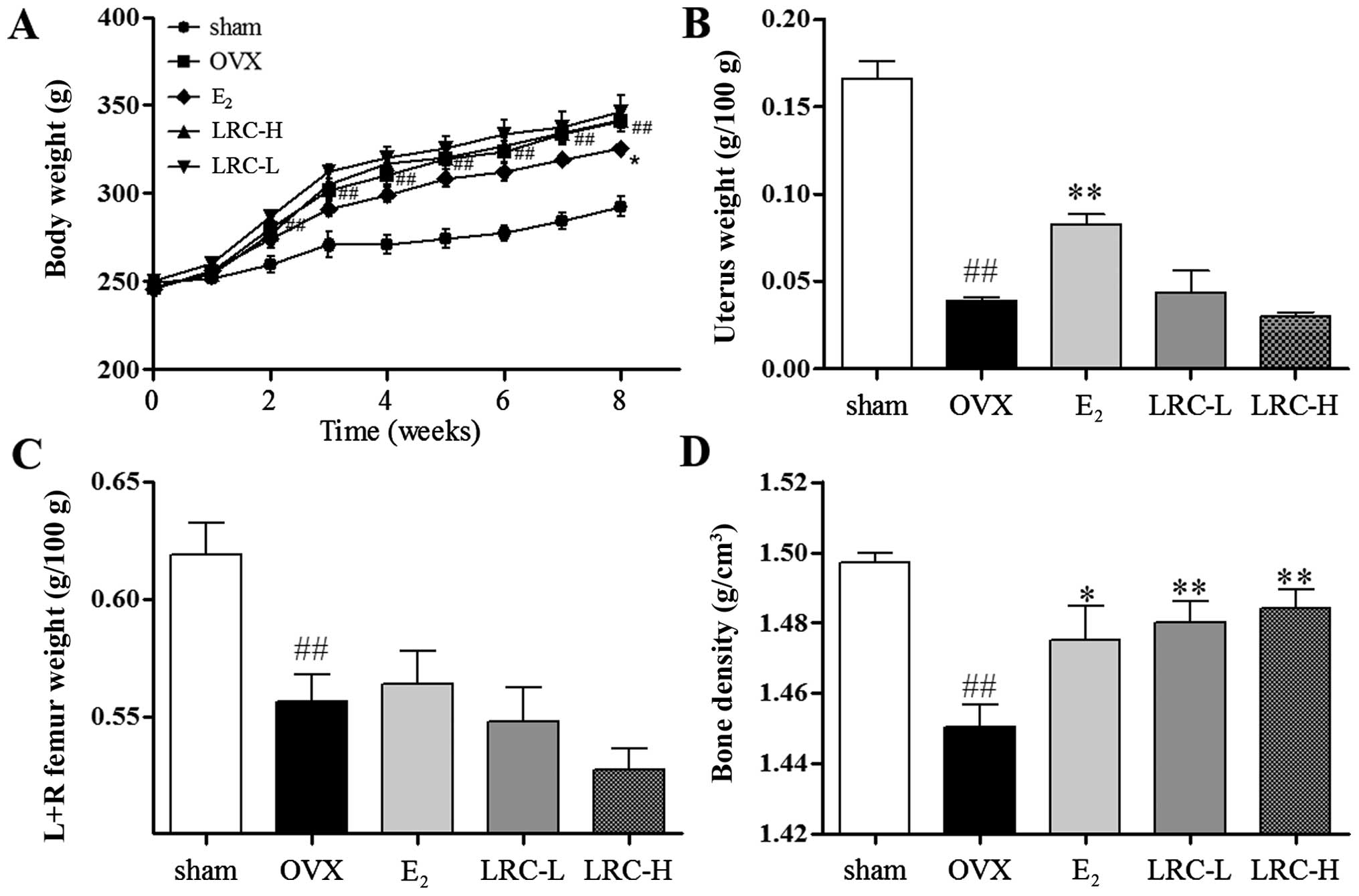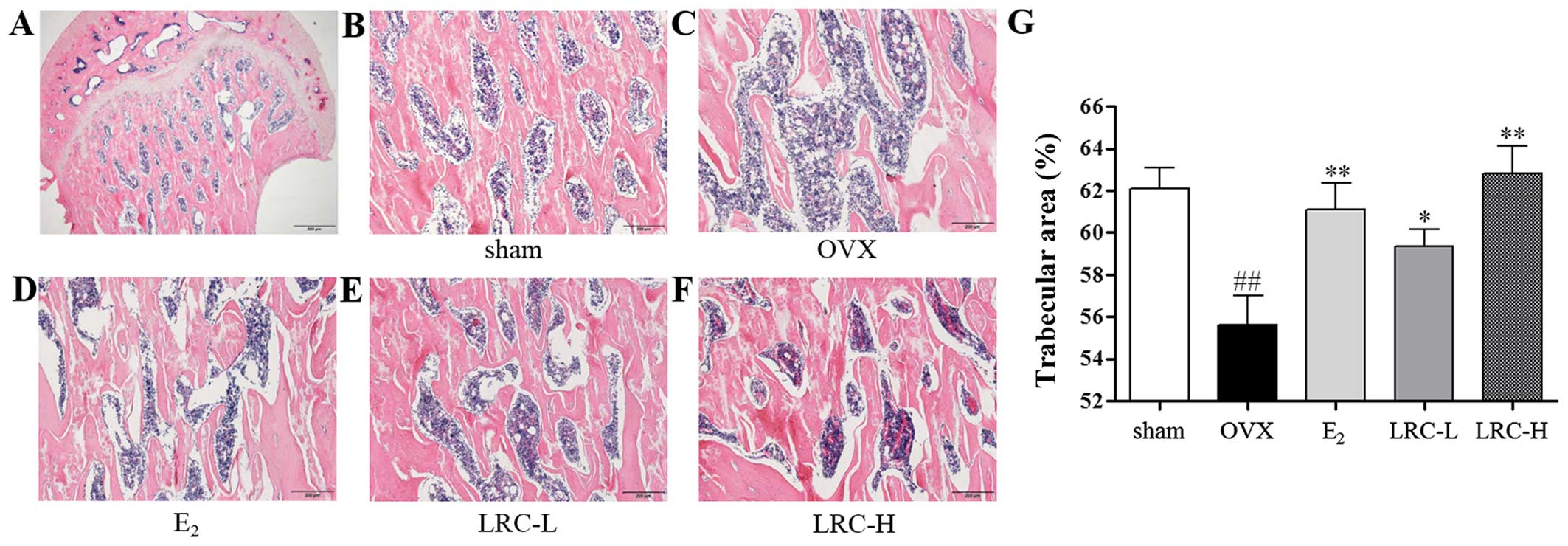|
1
|
Burge R, Dawson-Hughes B, Solomon DH, Wong
JB, King A and Tosteson A: Incidence and economic burden of
osteoporosis-related fractures in the United States, 2005–2025. J
Bone Miner Res. 22:465–475. 2007. View Article : Google Scholar
|
|
2
|
Teitelbaum SL: Bone resorption by
osteoclasts. Science. 289:1504–1508. 2000. View Article : Google Scholar : PubMed/NCBI
|
|
3
|
Rodan GA and Martin TJ: Therapeutic
approaches to bone diseases. Science. 289:1508–1514. 2000.
View Article : Google Scholar : PubMed/NCBI
|
|
4
|
Boyle WJ, Simonet WS and Lacey DL:
Osteoclast differentiation and activation. Nature. 423:337–342.
2003. View Article : Google Scholar : PubMed/NCBI
|
|
5
|
Wensel TM, Iranikhah MM and Wilborn TW:
Effects of denosumab on bone mineral density and bone turnover in
postmenopausal women. Pharmacotherapy. 31:510–523. 2011. View Article : Google Scholar : PubMed/NCBI
|
|
6
|
de Villiers TJ: Bone health and
osteoporosis in postmenopausal women. Best Pract Res Clin Obstet
Gynaecol. 23:73–85. 2009. View Article : Google Scholar
|
|
7
|
Collin-Osdoby P and Osdoby P:
RANKL-mediated osteoclast formation from murine RAW 264.7 cells.
Methods Mol Biol. 816:187–202. 2012. View Article : Google Scholar
|
|
8
|
Suda T, Takahashi N, Udagawa N, Jimi E,
Gillespie MT and Martin TJ: Modulation of osteoclast
differentiation and function by the new members of the tumor
necrosis factor receptor and ligand families. Endocr Rev.
20:345–357. 1999. View Article : Google Scholar : PubMed/NCBI
|
|
9
|
Grigoriadis AE, Wang ZQ, Cecchini MG,
Hofstetter W, Felix R, Fleisch HA and Wagner EF: c-Fos: a key
regulator of osteoclast-macrophage lineage determination and bone
remodeling. Science. 266:443–448. 1994. View Article : Google Scholar : PubMed/NCBI
|
|
10
|
Zhao Q, Wang X, Liu Y, He A and Jia R:
NFATc1: functions in osteoclasts. Int J Biochem Cell Biol.
42:576–579. 2010. View Article : Google Scholar
|
|
11
|
Choi HJ, Park YR, Nepal M, Choi BY, Cho
NP, Choi SH, Heo SR, Kim HS, Yang MS and Soh Y: Inhibition of
osteoclastogenic differentiation by Ikarisoside A in RAW 264.7
cells via JNK and NF-kappaB signaling pathways. Eur J Pharmacol.
636:28–35. 2010. View Article : Google Scholar : PubMed/NCBI
|
|
12
|
Fujisaki K, Tanabe N, Suzuki N, Kawato T,
Takeichi O, Tsuzukibashi O, Makimura M, Ito K and Maeno M: Receptor
activator of NF-kappaB ligand induces the expression of carbonic
anhydrase II, cathepsin K, and matrix metalloproteinase-9 in
osteoclast precursor RAW264.7 cells. Life Sci. 80:1311–1318. 2007.
View Article : Google Scholar : PubMed/NCBI
|
|
13
|
Wimalawansa SJ: Prevention and treatment
of osteoporosis: efficacy of combination of hormone replacement
therapy with other antiresorptive agents. J Clin Densitom.
3:187–201. 2000. View Article : Google Scholar : PubMed/NCBI
|
|
14
|
Alexandersen P, Toussaint A, Christiansen
C, Devogelaer JP, Roux C, Fechtenbaum J, Gennari C and Reginster
JY; Ipriflavone Multicenter European Fracture S; Ipriflavone
Multicenter European Fracture Study: Ipriflavone in the treatment
of postmenopausal osteoporosis: a randomized controlled trial.
JAMA. 285:1482–1488. 2001. View Article : Google Scholar : PubMed/NCBI
|
|
15
|
Herbal Pharmacology Compilation Committee:
Herbal Pharmacology. Shinil books, Seoul. 715–717. 2010.
|
|
16
|
Herbology Editorial Committee of Korean
Medicine schools: Boncho-hak [Herbology]. Younglimsa; Seoul: pp.
534–535. 2004
|
|
17
|
Song MY, Jung HW, Kang SY, Kim KH and Park
YK: Anti-inflammatory effect of Lycii radicis in LPS-stimulated RAW
264.7 macrophages. Am J Chin Med. 42:891–904. 2014. View Article : Google Scholar : PubMed/NCBI
|
|
18
|
Cho SH, Park EJ, Kim EO and Choi SW: Study
on the hypochlolesterolemic and antioxidative effects of tyramine
derivatives from the root bark of Lycium chenese Miller. Nutr Res
Pract. 5:412–420. 2011. View Article : Google Scholar : PubMed/NCBI
|
|
19
|
Kim SJ, Lee L, Kim JH, Lee TH and Shim I:
Antidepressant-like effects of lycii radicis cortex and betaine in
the forced swimming test in rats. Biomol Ther (Seoul). 21:79–83.
2013. View Article : Google Scholar
|
|
20
|
Jeong JC, Kim SJ, Kim YK, Kwon CH and Kim
KH: Lycii cortex radicis extract inhibits glioma tumor growth in
vitro and in vivo through downregulation of the Akt/ERK pathway.
Oncol Rep. 27:1467–1474. 2012.PubMed/NCBI
|
|
21
|
Gao D, Li Q, Liu Z, Li Y, Liu Z, Fan Y, Li
K, Han Z and Li J: Hypoglycemic effects and mechanisms of action of
Cortex Lycii Radicis on alloxan-induced diabetic mice. Yakugaku
Zasshi. 127:1715–1721. 2007. View Article : Google Scholar : PubMed/NCBI
|
|
22
|
Kalu DN: The ovariectomized rat model of
postmenopausal bone loss. Bone Miner. 15:175–191. 1991. View Article : Google Scholar : PubMed/NCBI
|
|
23
|
Arjmandi BH, Alekel L, Hollis BW, Amin D,
Stacewicz-Sapuntzakis M, Guo P and Kukreja SC: Dietary soybean
protein prevents bone loss in an ovariectomized rat model of
osteoporosis. J Nutr. 126:161–167. 1996.PubMed/NCBI
|
|
24
|
Hsu H, Lacey DL, Dunstan CR, Solovyev I,
Colombero A, Timms E, Tan HL, Elliott G, Kelley MJ, Sarosi I, et
al: Tumor necrosis factor receptor family member RANK mediates
osteoclast differentiation and activation induced by
osteoprotegerin ligand. Proc Natl Acad Sci USA. 96:3540–3545. 1999.
View Article : Google Scholar : PubMed/NCBI
|
|
25
|
Tanaka H, Tanabe N, Shoji M, Suzuki N,
Katono T, Sato S, Motohashi M and Maeno M: Nicotine and
lipopolysaccharide stimulate the formation of osteoclast-like cells
by increasing macrophage colony-stimulating factor and
prostaglandin E2 production by osteoblasts. Life Sci. 78:1733–1740.
2006. View Article : Google Scholar
|
|
26
|
Tanabe N, Maeno M, Suzuki N, Fujisaki K,
Tanaka H, Ogiso B and Ito K: IL-1 alpha stimulates the formation of
osteoclast-like cells by increasing M-CSF and PGE2
production and decreasing OPG production by osteoblasts. Life Sci.
77:615–626. 2005. View Article : Google Scholar : PubMed/NCBI
|
|
27
|
Kim SN, Kim MH, Min YK and Kim SH:
Licochalcone A inhibits the formation and bone resorptive activity
of osteoclasts. Cell Biol Int. 32:1064–1072. 2008. View Article : Google Scholar : PubMed/NCBI
|
|
28
|
Jun AY, Kim HJ, Park KK, Son KH, Lee DH,
Woo MH, Kim YS, Lee SK and Chung WY: Extract of Magnoliae Flos
inhibits ovariectomy-induced osteoporosis by blocking
osteoclastogenesis and reducing osteoclast-mediated bone
resorption. Fitoterapia. 83:1523–1531. 2012. View Article : Google Scholar : PubMed/NCBI
|
|
29
|
Kim K, Lee SH, Ha Kim J, Choi Y and Kim N:
NFATc1 induces osteoclast fusion via up-regulation of Atp6v0d2 and
the dendritic cell-specific transmembrane protein (DC-STAMP). Mol
Endocrinol. 22:176–185. 2008. View Article : Google Scholar
|
|
30
|
Winslow MM, Pan M, Starbuck M, Gallo EM,
Deng L, Karsenty G and Crabtree GR: Calcineurin/NFAT signaling in
osteoblasts regulates bone mass. Dev Cell. 10:771–782. 2006.
View Article : Google Scholar : PubMed/NCBI
|
|
31
|
Takahashi S, Goldring S, Katz M,
Hilsenbeck S, Williams R and Roodman GD: Downregulation of
calcitonin receptor mRNA expression by calcitonin during human
osteoclast-like cell differentiation. J Clin Invest. 95:167–171.
1995. View Article : Google Scholar : PubMed/NCBI
|
|
32
|
Wang ZQ, Ovitt C, Grigoriadis AE,
Möhle-Steinlein U, Rüther U and Wagner EF: Bone and haematopoietic
defects in mice lacking c-fos. Nature. 360:741–745. 1992.
View Article : Google Scholar : PubMed/NCBI
|
|
33
|
David JP, Rincon M, Neff L, Horne WC and
Baron R: Carbonic anhydrase II is an AP-1 target gene in
osteoclasts. J Cell Physiol. 188:89–97. 2001. View Article : Google Scholar : PubMed/NCBI
|
|
34
|
Sundaram K, Nishimura R, Senn J, Youssef
RF, London SD and Reddy SV: RANK ligand signaling modulates the
matrix metalloproteinase-9 gene expression during osteoclast
differentiation. Exp Cell Res. 313:168–178. 2007. View Article : Google Scholar
|
|
35
|
Andersen TL, del Carmen Ovejero M,
Kirkegaard T, Lenhard T, Foged NT and Delaissé JM: A scrutiny of
matrix metalloproteinases in osteoclasts: evidence for
heterogeneity and for the presence of MMPs synthesized by other
cells. Bone. 35:1107–1119. 2004. View Article : Google Scholar : PubMed/NCBI
|
|
36
|
Versi E, Harvey MA, Cardozo L, Brincat M
and Studd JW: Urogenital prolapse and atrophy at menopause: a
prevalence study. Int Urogynecol J Pelvic Floor Dysfunct.
12:107–110. 2001. View Article : Google Scholar : PubMed/NCBI
|
|
37
|
Lim DW, Kim JG, Lee Y, Cha SH and Kim YT:
Preventive effects of Eleutherococcus senticosus bark extract in
OVX-induced osteoporosis in rats. Molecules. 18:7998–8008. 2013.
View Article : Google Scholar : PubMed/NCBI
|
|
38
|
Lim DW and Kim YT: Dried root of Rehmannia
glutinosa prevents bone loss in ovariectomized rats. Molecules.
18:5804–5813. 2013. View Article : Google Scholar : PubMed/NCBI
|
|
39
|
Hidaka S, Okamoto Y, Nakajima K, Suekawa M
and Liu SY: Preventive effects of traditional Chinese (Kampo)
medicines on experimental osteoporosis induced by ovariectomy in
rats. Calcif Tissue Int. 61:239–246. 1997. View Article : Google Scholar : PubMed/NCBI
|
|
40
|
Dang ZC, van Bezooijen RL, Karperien M,
Papapoulos SE and Löwik CW: Exposure of KS483 cells to estrogen
enhances osteogenesis and inhibits adipogenesis. J Bone Miner Res.
17:394–405. 2002. View Article : Google Scholar : PubMed/NCBI
|
|
41
|
Wronski TJ, Lowry PL, Walsh CC and
Ignaszewski LA: Skeletal alterations in ovariectomized rats. Calcif
Tissue Int. 37:324–328. 1985. View Article : Google Scholar : PubMed/NCBI
|
|
42
|
Kalu DN, Liu CC, Salerno E, Hollis B,
Echon R and Ray M: Skeletal response of ovariectomized rats to low
and high doses of 17 beta-estradiol. Bone Miner. 14:175–187. 1991.
View Article : Google Scholar : PubMed/NCBI
|
|
43
|
Hui SL, Slemenda CW and Johnston CC Jr:
Baseline measurement of bone mass predicts fracture in white women.
Ann Intern Med. 111:355–361. 1989. View Article : Google Scholar : PubMed/NCBI
|



